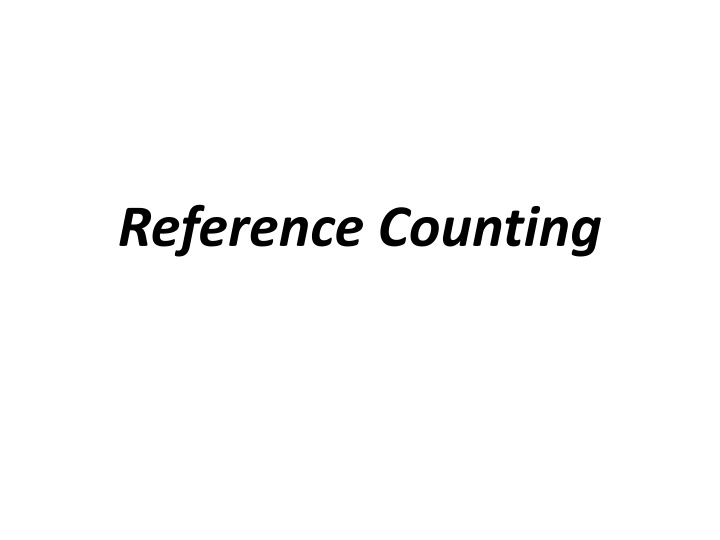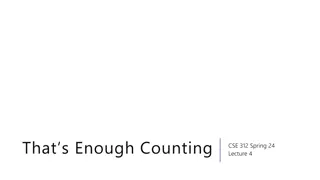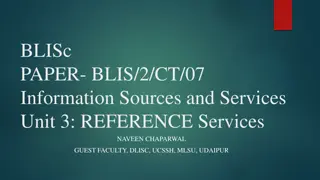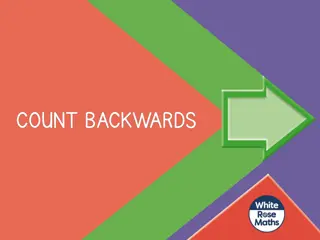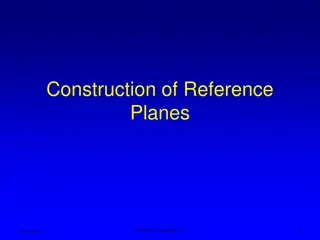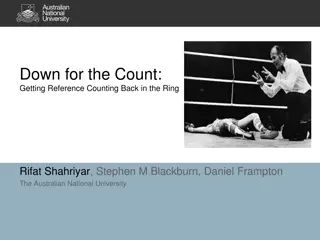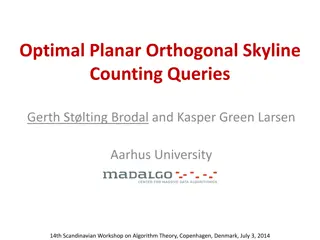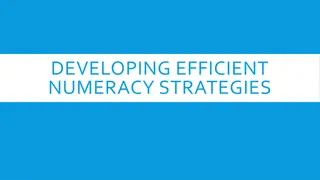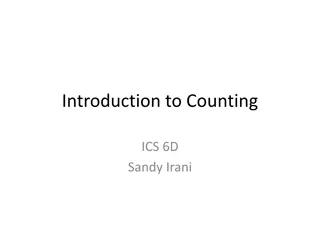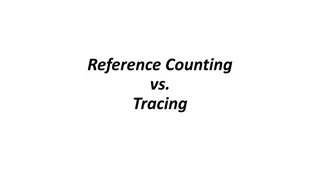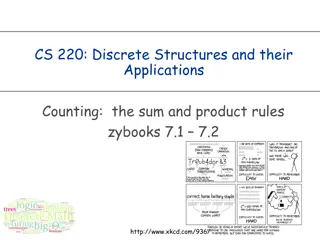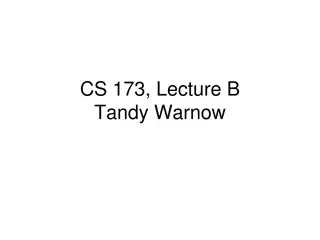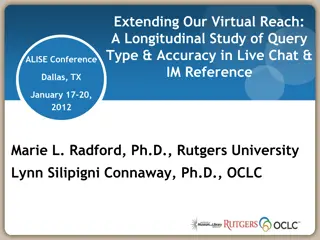Reference Counting
Garbage collection methods like Reference Counting and Tracing play crucial roles in memory management. This overview discusses the advantages and disadvantages of each method, highlighting their differences in overhead, simplicity, and performance. The key concepts of reference counting by Collins (1960) and basics of implementation are explored, along with insights on write barriers, cycles in algorithms, and lazy freeing techniques proposed by Weizenbaum (1963). These techniques aim to improve efficiency and manage memory allocation effectively in modern software systems.
Download Presentation

Please find below an Image/Link to download the presentation.
The content on the website is provided AS IS for your information and personal use only. It may not be sold, licensed, or shared on other websites without obtaining consent from the author.If you encounter any issues during the download, it is possible that the publisher has removed the file from their server.
You are allowed to download the files provided on this website for personal or commercial use, subject to the condition that they are used lawfully. All files are the property of their respective owners.
The content on the website is provided AS IS for your information and personal use only. It may not be sold, licensed, or shared on other websites without obtaining consent from the author.
E N D
Presentation Transcript
Reference Counting vs. Tracing Advantages Immediate Object-local Overhead distributed Very simple Trivial implementation for na ve RC Disadvantages Maintain count Time and space overheads Cycles Can t be collected Complex High performance implementation about as complex as tracing 2
Garbage collection is ubiquitous Two ideas underpin large literature: - Tracing [McCarthy60] - Reference Counting [Collins60] However Tracing used in all high performance GCs Reference counting only in non-performance critical settings 3
Reference counting [Collins 1960] Associate a reference count field with each object how many pointers reference this object When nothing points to an object, it can be deleted Decrement count for all descendants of dead objects 4
Basic Reference Counting 1 1 0 1 1 2 3 2 1 1 A B C D E E F 5
Write Barriers Small piece of code Used to intercept pointer writes Generated by the compiler 6
Cycles? [Harold-McBeth 1963] Reference counting algorithm does not reclaim cycles! But, it turns out that typical programs do not use too many cyclic structures This is correct also for modern benchmarks (including SPECjbb2000) So, other methods are used seldom to collect the cycles 7
Lazy Freeing [Weizenbaum, 1963] Problem: uneven processing overheads. Cost of deleting last pointer to an object O depends on size of sub-graph rooted at O Solution: lazy freeing Free lazily with a stack When last pointer to O deleted: push O to stack During allocation: pop O from stack, free O, decrement rc for children of O If any got down to 0 push it to the stack 8
Lazy Freeing Properties Advantage Splitting the costs of deletion evenly throughout the computation Efficiency (almost) unchanged: deletion is just spread into many allocation operations Disadvantages: Complication of the allocation process It may take time to realize that a large consecutive space has been freed 9
Sticky reference counts Problem: Space overhead for ref counters Theoretically, large enough to hold number of pointers in the heap Idea: use small rc fields (may overflow) When rc overflows, think of it as stuck Stuck rc s are not decremented/incremented To reclaim objects with stuck rc, their rc values must be restored 10
Restoring reference counts Auxiliary data structures to store count of the overflowedobjects Hash Table can be used Cycle collector Ignore them (let backup tracing collect stuck objects) Restore them (let backup tracing restore stuck counts) 12
Deferred Reference Counting Problem: overhead on updating changes to stacks and registers is too high Solution [Deutch & Bobrow, 1976] Don t update rc for stacks and registers rc s reflect only references from heap objects not from stack We can t delete objects whose rc drops to zero Instead objects with rc = 0 are pushed to ZCT (Zero Count Table) Once in a while : collect all objects with rc=0 that are not referenced from stacks and registers 13
Deferred RC Properties Advantages: Deferred RC reduces overhead by 80%. Disadvantages: Immediacy of collection lost ! Space overhead for ZCT. Used in most modern RC systems 14
Deferral [Deutsch and Bobrow 1976, Bacon et al. 2001] Stacks & Registers 1 2 1 1 0 1 1 2 2 1 2 B C D E F A ++ -- --' mutator activity GC: scan roots GC: apply increments GC: apply decrements GC: collect GC: move deferred decs A-- A-- A-- F-- D++ A++ F++ B-- F-- 15
Coalescing [Levanoni and Patrank 2001] E++ E-- F++ C++ C-- D++ D-- B-- A B C D E F Remember A Ignore intermediate mutations Compare A, Aold B--, F++ 16
Cycles in Reference Counting Systems Reference counting collectors employ one of 2 avenues to collect garbage cycles: A backup tracing collector Trace all live objects and sweep the entire heap Can also restore reference counts A cycle collector Known as trial deletion 17
Cycle Collection Basic Idea - 1 Observation 1: Garbage cycles can only be created when a rc is decremented to a non-zero value Objects whose rc is decremented to a non-zero value become candidates 18
Cycle Collection Basic Idea - 2 Sub-graph of O graph of objects reachable from O External pointer (to a sub-graph) a pointer from a non sub-graph object to a sub-graph object Internal pointer (of a sub-graph) a pointer between 2 sub-graph objects a o o1 o2 o3 o4 o5 19
Cycle Collection Basic Idea - 2 Observation 2: In a garbage cycle all the reference counts are due to internal pointer of the cycle For each candidate s sub-graph, check if external pointers point to this sub-graph 20
Counts for External Pointers Only r r r 1 1 1 2 a 1 a 0 a a garbage cycle b b b 1 1 0 Not a garbage cycle c d c d c d 2 2 2 2 0 1 rc s when ignoring internal edges edge r->a deleted 21
Implementing the Cycle Collector Idea Object is colored black/gray/ white. Whenever rc of an object a is decremented to a non-zero, perform local traversals over the graph of objects of a . Mark: Updates rc s to reflect only pointers that are external to the graph of a , marking nodes in gray Scan: Restores rc s of the externally reachable objects, coloring them in black. Rest of the nodes are white. Collect: collects garbage objects (the white ones). r 1 1 1 0 0 2 a b 1 0 0 c d 2 1 1 2 2 1 0 0 1 22
